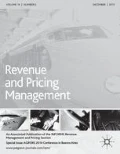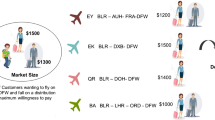Abstract
Forecasting is at the heart of every revenue management system, providing necessary input to capacity control, pricing and overbooking functionalities. For airlines, the key to efficient capacity control is determining the time of when to restrict bookings in a lower-fare class to leave space for later booking high-fare customers. This work presents findings of a collaboration project between Bournemouth University and Lufthansa Systems AG, a company providing revenue management software for airline carriers. The main aim is to increase net booking forecast accuracy by modifying one of its components, the cancellation forecast. Complementing an available set of three traditional individual algorithms, an additional method is presented and added to the method pool. Furthermore, diversification of model parameters and level of learning is discussed to increase the number of individual forecasts even further. Finally, the evolution of forecast combination structures is investigated and shown to be beneficial on an airline data set.





Similar content being viewed by others
References
Aiolfi, M. and Timmermann, A. (2006) Persistence in forecasting performance and conditional combination strategies. Journal of Econometrics 127 (1–2): 31–53.
Athanasopoulos, G., Ahmed, R.A. and Hyndman, R.J. (2009) Hierarchical forecasts for Australian domestic tourism. International Journal of Forecasting 25 (1): 146–166.
Batchelor, R. and Dua, P. (1995) Forecaster diversity and the benefits of combining forecasts. Management Science 41 (1): 685.
Bates, J. and Granger, C. (1969) The combination of forecasts. Operational Research 20 (4): 451–468.
Breiman, L. (1996) Bagging predictors. Machine Learning 24 (2): 123–140.
Brown, G., Wyatt, J. and Tino, P. (2005) Managing diversity in regression ensembles. The Journal of Machine Learning Research 6: 1621–1650.
Bunn, D. (1975) A Bayesian approach to the linear combination of forecasts. Operational Research Quarterly 26 (2): 325–329.
Donaldson, R.G. and Kamstra, M. (1999) Neural network forecast combining with interaction effects. Journal of The Franklin Institute 336 (2): 227–236.
Fodor, I.K. (2002) A Survey of Dimension Reduction Techniques. Center for Applied Scientific Computing, Technical report. Lawrence Livermore National Laboratory.
Frantti, T. and Mähönen, P. (2001) Fuzzy logic-based forecasting model. Engineering Applications of Artificial Intelligence 14 (2): 189–201.
Freund, Y. and Schapire, R.E. (1997) A decision-theoretic generalization of on-line learning and an application to boosting. Journal of Computer and System Sciences 55 (1): 119–139.
Gabrys, B. and Ruta, D. (2005) Classifier selection for majority voting. Information Fusion 6 (1): 63–81.
Garrow, L. and Koppelman, F. (2004) Multinomial and nested logit models of airline passengers’ no-show and standby behaviour. Journal of Revenue and Pricing Management 3 (3): 237–253.
Goldberg, D. and Holland, J. (1988) Genetic algorithms and machine learning. Machine Learning 3 (2–3): 959.
Granger, C. and Jeon, Y. (2004) Thick modeling. Economic Modelling 21 (2): 323–343.
Hansen, J.V. (2000) Combining predictors: Meta machine learning methods and bias/variance & ambiguity decompositions. PhD. thesis, Department of Computer Science, University of Aarhus.
Jain, C.L. (2008) Benchmarking forecasting models. Journal of Business Forecasting 26 (Winter 2007–2008): 15–18.
Jolliffe, I. (2002) Principal Component Analysis, 2nd edn. New York: Springer.
Koza, J.R. (1992) Genetic Programming. Cambridge, MA: MIT Press.
Krogh, A. and Vedelsby, J. (1995) Neural network ensembles, cross-validation and active learning. Advances in Neural Information Processing Systems 7: 231–238.
Kuncheva, L. (2004) Combining Pattern Classifiers: Methods and Algorithms. New York: John Wiley & Sons.
Kuncheva, L.I. and Whitaker, C.J. (2003) Measures of diversity in classifier ensembles. Machine Learning 51 (2): 181–207.
Lee, A. (1990) Airline reservations forecasting: Probabilistic and statistical models of the booking process. PhD. thesis, Massachusetts Institute of Technology.
Liu, Y. (2005) Value-at-risk Model Combination Using Artificial Neural Networks. Emory University Working Paper Series. Technical Report.
Makridakis, S. and Hibon, M. (2000) The M3-competition: Results, conclusions and implications. International Journal of Forecasting 16 (4): 451–476.
Makridakis, S., Wheelwright, S. and Hyndman, R. (1998) Forecasting: Methods and Applications, 3rd edn. New York: John Wiley.
McGill, J. and van Ryzin, G. (1999) Revenue management: Research overview and prospects. Transportation Science 33 (2): 233–256.
Neuling, R., Riedel, S. and Kalka, K.U. (2004) New approaches to origin and destination and no-show forecasting: Excavating the passenger name records treasure. Journal of Revenue and Pricing Management 3 (1): 62–72.
Newbold, P. and Granger, C. (1974) Experience with forecasting univariate time series and the combination of forecasts. Journal of the Royal Statistical Society, Series A (General) 137 (2): 131–165.
Ozun, A. and Cifter, A. (2007) Nonlinear Combination of Financial Forecast With Genetic Algorithm. Technical Report. University of Munich.
Pak, K. and Piersma, N. (2002) Airline Revenue Management: An Overview of OR Techniques 1982–2001. Technical Report. Econometric Institute Report EI.
Poelt, S. (1998) Forecasting is difficult – Especially if it refers to the future. Presentation at AGIFORS, Reservations and Yield Management Study Group Annual Meeting, Melbourne, Australia.
Riedel, S. (2007) Forecast combination in revenue management demand forecasting. PhD. thesis, Bournemouth University in collaboration with Lufthansa Systems Berlin GmbH.
Riedel, S. and Gabrys, B. (2004) Hierarchical multilevel approaches of forecast combination. In: H. Fleuren, D. den Hertog and P. Kor, (eds.) Operations Research Proceedings 2004: Selected Papers of the Annual International Conference of the German Operations Research Society (GOR). Jointly Organized with the Netherlands Society for Operations Research (NGB) Tilburg, 1–3 September. Heidelberg, Berlin: Springer, pp. 479–486.
Riedel, S. and Gabrys, B. (2005) Evolving multilevel forecast combination models-an experimental study. In: NiSIS'2005 (Nature-Inspired Smart information Systems) Symposium, 4–5 October, Albufeira, Portugal.
Riedel, S. and Gabrys, B. (2007) Dynamic Pooling for the Combination of Forecasts Generated using Multi Level Learning. Proceedings of the International Joint Conference on Neural Networks, 12–17 August, Orlando, FL, pp. 454–459.
Riedel, S. and Gabrys, B. (2009) Pooling for combination of multi level forecasts. IEEE Transactions on Knowledge and Data Engineering 12 (21): 1753–1766.
Swanson, N. and Zeng, T. (2001) Choosing among competing econometric forecasts: Regression-based forecast combination using model selection. Journal of Forecasting 20 (6): 425–440.
Talluri, K.T. and van Ryzin, G. (2005) The Theory and Practice of Revenue Management. New York: Springer.
Terui, N. and van Dijk, H.K. (2002) Combined forecasts from linear and nonlinear time series models. International Journal of Forecasting 18 (3): 421–438.
Timmermann, A. (2006) Forecast combinations. In: G. Elliott, C. Granger and A. Timmermann (eds.) Handbook of Economic Forecasting. North Holland, Amsterdam: Elsevier, pp. 135–196.
Weatherford, L. and Kimes, S. (2003) A comparison of forecasting methods for hotel revenue management. International Journal of Forecasting 19 (3): 401–415.
Zaki, H. (2000) Forecasting for airline revenue management. Journal of Business Forecasting Methods and Systems 19 (1): 2–7.
Zeni, R.H. (2001) Improved forecast accuracy in airline revenue management by unconstraining demand estimates from censored data. PhD. thesis, Graduate School, Newark.
Zhang, G.P. (2004) A Combined Arima and Neural Network Approach for Time Series Forecasting. Neural Networks in Business Forecasting. Hershey, PA: Idea Group Publishing, pp. 213–225.
Author information
Authors and Affiliations
Additional information
1received a graduate degree in Computer Science/Intelligent Systems from Brandenburg University of Applied Sciences in Germany in 2004, where she continued working in the area of robotics and image recognition for 2 years. In 2006, she started her PhD studies at Bournemouth University, UK and successfully defended her thesis in March 2010. Her main research interests include the combinations of time-series forecasts and meta-learning.
2works as a Scientific Analyst at Lufthansa Systems AG, Berlin. She received a PhD degree from Bournemouth University in 2008.
3received an MSc degree in Electronics and Telecommunication (Specialization: Computer Control Systems) from the Silesian Technical University, Poland in 1994 and a PhD in Computer Science from the Nottingham Trent University, UK in 1998. After many years of working at different Universities, Professor Gabrys moved to Bournemouth University in January 2003 where he acts as a Director of the Smart Technology Research Centre within the School of Design, Engineering and Computing. His current research interests include a wide range of machine learning and hybrid intelligent techniques encompassing data and information fusion, multiple classifier and prediction systems, processing and modelling of uncertainty in pattern recognition, diagnostic analysis and decision support systems.
Rights and permissions
About this article
Cite this article
Lemke, C., Riedel, S. & Gabrys, B. Evolving forecast combination structures for airline revenue management. J Revenue Pricing Manag 12, 221–234 (2013). https://doi.org/10.1057/rpm.2012.30
Received:
Revised:
Published:
Issue Date:
DOI: https://doi.org/10.1057/rpm.2012.30




